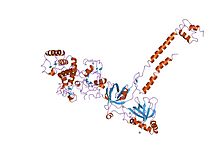DSS1/SEM1 protein family
| DSS1_SEM1 | |||||||||
|---|---|---|---|---|---|---|---|---|---|
 structure of a brca2-dss1 complex | |||||||||
| Identifiers | |||||||||
| Symbol | DSS1_SEM1 | ||||||||
| Pfam | PF05160 | ||||||||
| InterPro | IPR007834 | ||||||||
| SCOP2 | 1iyj / SCOPe / SUPFAM | ||||||||
| |||||||||
In molecular biology, the DSS1/SEM1 protein family is a family of short acidic proteins which includes the 26S proteasome complex subunits SEM1 from Saccharomyces cerevisiae and Drosophila and DSS1 (SHFM1) in mammals. In Saccharomyces cerevisiae, SEM1 is a regulator of both exocyst function and pseudohyphal differentiation.[1] Loss of DSS1 in Homo sapiens (human) has been associated with split hand/split foot malformations.[2] DSS1 is playing role as a modifier in a novel protein posttranslational modification, referred to as DSSylation, which is probably targeting oxidized proteins and guiding them to proteasomal degradation.[3]
References[edit]
- ^ Jantti J, Lahdenranta J, Olkkonen VM, Soderlund H, Keranen S (February 1999). "SEM1, a homologue of the split hand/split foot malformation candidate gene Dss1, regulates exocytosis and pseudohyphal differentiation in yeast". Proc. Natl. Acad. Sci. U.S.A. 96 (3): 909–14. Bibcode:1999PNAS...96..909J. doi:10.1073/pnas.96.3.909. PMC 15324. PMID 9927667.
- ^ Ignatius J, Knuutila S, Scherer SW, Trask B, Kere J (June 1996). "Split hand/split foot malformation, deafness, and mental retardation with a complex cytogenetic rearrangement involving 7q21.3". J. Med. Genet. 33 (6): 507–10. doi:10.1136/jmg.33.6.507. PMC 1050639. PMID 8782053.
- ^ Yinghao Zhang; Fang-Mei Chang; Jianjun Huang; Jacob J. Junco; Shivani K. Maffi; Hannah I. Pridgen; Gabriel Catano; Hong Dang; Xiang Ding; Fuquan Yang; Dae Joon Kim; Thomas J. Slaga; Rongqiao He; Sung-Jen Wei (February 2014). "DSSylation, a novel protein modification targets proteins induced by oxidative stress, and facilitates their degradation in cells". Protein Cell. 5 (2): 124–140. doi:10.1007/s13238-013-0018-8. PMC 3956975. PMID 24515614.
